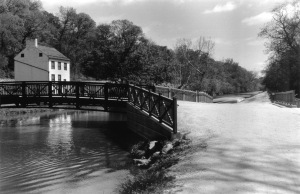Llewellyn Berry
A Perfect Storm
Posted on February 2, 2011by Llewellyn Berry
Sometimes there is a “perfect storm” – a coalescence of all the elements of a well exposed negative. The composition works, there is detail in the shadow area as well as the highlight area. The lines direct the eye to points of interest. Sometimes after you find this image even before you make the exposure you just sigh with a big smile…take the picture, dummy, before the light changes because of an errant cloud…Ok.
I ventured out one day along the C&O Canal west of Georgetown, looking for images on which light might play an integral role in creating an effect that struck me, as interesting. Under a bridge, there was a jogger putting on a shoe and the shadow of the bridge, as well as the bridge itself, created a crosshatch of lines that was an okay image. I took the shot; I took a few.
There was graffiti on the wall under the bridge. It too had a distinct shadow on it and the message plus the shadow plus the lines of the bridge created an okay image. I took the shot…ho hum!
I continued down the path and then, there it was. It stared at me. It cried out to me, “Lew take this picture; I’m yours and you will be really happy with me for a very long time.” So, I did and yes, I have been happy with it for a very long time. It was indeed, that “perfect storm” of composition and exposure.
This is a photograph that has all the classic components. There is a complete tonal range from pure white to pure black and all the grays in between. The composition is well balanced and roads and bridge paths – lines – that direct the eye to the house. From the house, the line of trees and the path direct the eye to a vanishing point into the distance. There is detail in shadow areas as well as highlight areas. There is movement in the ripples of the water in the canal.
This was not luck… well, unless you count the serendipity of the beautiful sky, the clouds, and the ripple of the water. The “not luck” part is in the recognition of the potential for a photograph. It is the pre-visualization that guides the capture of this image. I saw it immediately and although I took two shots of it, the second shot is virtually identical to the first. I think there might be a quarter of an f/stop difference between the first and the second.
However, this was initially recognizing the scene; then it was the camera’s meter measuring all the important areas of what was in the viewfinder. This was film not digital.
As I look at the print, there is a distinct difference between the image white and the paper white – clear borders all around. The bridge empties the eye onto the towpath.
Often images emerge like that but it is the ability to recognize them that is attributable to the practice of photography. I have had students who in class produced a contact sheet which had one really interesting frame amidst 35 others that were not so interesting. Yet, what was important was that they saw that one. It was my task to build on that one they saw and point out and encourage the same visual dynamic as they approached the next roll of film and the next photo assignment. What was important to me and ultimately to them was the process by which they were seeing. I looked at the first shot, then the second and so on and so on. It was that process and that fluidity that was essentially the making of visual literacy.
With the shot or two shots of Fletcher’s Boat House, I really didn’t need the second shot but I couldn’t believe my eyes that this shot didn’t require some extra work. Nope. It was a “perfect storm”.
Fletcher’s Boat House
C&O Canal, Washington, DC
2000


